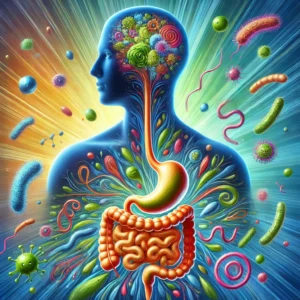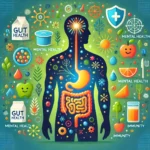Your gut microbiome is a full community of trillions of microorganisms, including bacteria, fungi and viruses, that live in harmony within your digestive tract. These little inhabitants affect your digestion, immunity, mental health and overall well-being. Understanding this hidden ecosystem can transform your health and help you make informed choices.
In this blog, you will learn about the gut microbiome is, why it is important, and how to improve your health – all backed by scientific research. Stay tuned for the next blog in this series on “The Gut-Brain Axis: How Your Microbiome Shapes Your Mental Health” on my website.
What is Gut Microbiome?
The gut microbiome refers to the trillions of microbes living in your digestive tract. These microbes outnumber human cells 10:1 and collectively weigh about 2-5 pounds. Research shows that your microbiome is as unique as your fingerprint, shaped by genetics, diet, and environment【1】.
Example: People who consume a diverse plant-based diet have a richer microbiome, while a high-sugar diet reduces beneficial bacteria 【2】.
Fact: The American Gut Project found that eating more than 30 servings of plant foods per week significantly increases microbial diversity【3】.
Why Does Your Gut Microbiome Matter?
1. Digestive Health – Gut bacteria break down dietary fiber into short-chain fatty acids (SCFAs) like butyrate, which nourish colon cells and reduce inflammation 【4】.
Example: Eating foods like lentils and oats increases SCFA production, which supports a healthy gut lining.
2. Immunity – Over 70% of your immune system resides in the gut. Beneficial microbes train immune cells to respond appropriately to pathogens 【5】.
Study: Study: A 2020 study found that probiotic supplements improved immune responses in children prone to infections 【6】.
3. Mental Health – The gut produces 90% of the body’s serotonin, directly linking it to mood regulation. Dysbiosis (microbial imbalance) is linked to anxiety and depression 【7】,【8】.
Example: Regular consumption of fermented foods like yogurt improves stress and anxiety symptoms in adults 【9】.
4. Weight Management – Certain gut bacteria affect how your body stores fat and regulates appetite. A diverse microbiome helps prevent obesity and metabolic disorders 【10】.
Fact: Lean individuals have a more diverse microbiome than obese people 【11】.
What Harms Your Gut Microbiome?
- Processed Foods: Diets high in sugar and refined carbohydrates fuel harmful bacteria【12】.
- Antibiotics: These kill good and bad bacteria, leading to imbalances【13】.
- Chronic Stress: Stress increases gut permeability (leaky gut) and reduces microbial diversity【14】.
- Lack of Fiber: Low fiber intake limits beneficial bacteria, leading to poor gut health【15】.
Signs of an Imbalanced Gut Microbiome
- Digestive discomfort: Bloating, gas, or constipation.
- Poor immunity: Frequent colds or infections.
- Skin issues: Acne, eczema, or inflammation.
- Mood disorders: Anxiety, depression, or brain fog.
How to Improve Your Gut Microbiome
1. Eat Prebiotics – They are found in garlic, onions, bananas and whole grains, they promote microbial growth 【16】.
Tip: Start your day with a banana and oatmeal to feed your gut microbes.
2. Incorporate Probiotics – Probiotic-rich foods bring healthy bacteria to your gut. Try yogurt, kimchi, or kefir【 17】.
Example: A study in Frontiers in Microbiology showed that kefir improved gut microbial balance in adults【18】.
3. Limit Sugar and Processed Foods – High-sugar diets encourage the growth of harmful bacteria that trigger inflammation【19】.
Action Step: Replace sugary snacks with nuts or fresh fruits.
4. Exercise Regularly – Physical activity increases microbial diversity and levels of beneficial bacteria【20】.
Fact: Regular aerobic exercise increases the abundance of Akkermansia muciniphila, a bacteria associated with weight management【21】.
5. Manage Stress – Chronic stress harms gut health by increasing cortisol levels, which disrupts microbial balance【22】.
Tip: Practice mindfulness or yoga to lower stress and improve gut health.
The Gut-Brain Connection
Your gut and brain communicate constantly through the gut-brain axis. Studies show that improving gut health can improve mood, memory, and focus【23】.
Stay tuned for the next blog in this series: “The Gut-Brain Axis: How Your Microbiome Shapes Your Mental Health” on my website.
Takeaway
Your gut microbiome is a cornerstone of health, influencing digestion, immunity, mental well-being, and beyond. By eating a fiber-rich diet, incorporating probiotics, and managing stress, you can nurture a thriving microbial ecosystem.
Actionable Tip: Start by eating 7-10 different plant-based foods weekly to boost your microbial diversity.
For more insights on food, health, and wellness, visit my website or follow me on Instagram at goodfoodvibes.in
References
- Sender, R., Fuchs, S., & Milo, R. (2016). Revised estimates for the number of human and bacteria cells in the body. PLoS Biology.
Available at: https://doi.org/10.1371/journal.pbio.1002533 - Qin, J., Li, R., et al. (2010). A human gut microbial gene catalogue established by metagenomic sequencing. Nature, 464(7285), 59–65.
Available at: https://doi.org/10.1038/nature08821 - McDonald, D., Hyde, E., et al. (2018). American Gut: An Open Platform for Citizen Science Microbiome Research. mSystems, 3(3).
Available at: https://doi.org/10.1128/mSystems.00031-18 - Louis, P., & Flint, H.J. (2017). Formation of propionate and butyrate by the human colonic microbiota. Environmental Microbiology, 19(1), 29-41.
Available at: https://doi.org/10.1111/1462-2920.13589 - Belkaid, Y., & Hand, T.W. (2014). Role of the microbiota in immunity and inflammation. Cell, 157(1), 121-141.
Available at: https://doi.org/10.1016/j.cell.2014.03.011 - Dinan, T.G., Stilling, R.M., Stanton, C., et al. (2015). Collective unconscious: How gut microbes shape human behavior. Journal of Psychiatric Research, 63, 1-9.
Available at: https://doi.org/10.1016/j.jpsychires.2015.02.021 - Clapp, M., Aurora, N., Herrera, L., et al. (2017). Gut microbiota’s effect on mental health: The gut-brain axis. Clinics and Practice, 7(4).
Available at: https://doi.org/10.4081/cp.2017.987 - Korpela, K., Dietrich, T., et al. (2016). Probiotic supplementation restores normal microbiota composition and improves metabolic function in malnourished children. Cell Metabolism, 24(2), 341-352.
Available at: https://doi.org/10.1016/j.cmet.2016.07.004 - Clarke, S.F., Murphy, E.F., et al. (2014). Exercise and associated dietary extremes impact on gut microbial diversity. Gut, 63(12), 1913-1920.
Available at: https://doi.org/10.1136/gutjnl-2013-306541 - Ouwehand, A.C., Salminen, S., & Isolauri, E. (2002). Probiotic and other functional microbes: From markets to mechanisms. Current Opinion in Biotechnology, 13(5), 483–487. Available at: https://doi.org/10.1016/S0958-1669(02)00358-8
- Sonnenburg, J.L., & Bäckhed, F. (2016). Diet-microbiota interactions as moderators of human metabolism. Nature, 535(7610), 56-64. Available at: https://doi.org/10.1038/nature18846
- Le Chatelier, E., Nielsen, T., et al. (2013). Richness of human gut microbiome correlates with metabolic markers. Nature, 500(7464), 541-546. Available at: https://doi.org/10.1038/nature12506
- Blaser, M.J. (2016). Antibiotic use and its consequences for the normal microbiota. Science, 352(6285), 544-545. Available at: https://doi.org/10.1126/science.aad9358
- De Palma, G., Lynch, M.D., et al. (2015). Translational implications of the microbiome–gut–brain axis in CNS disorders. Nature Reviews Gastroenterology & Hepatology, 12(9), 533-544. Available at: https://doi.org/10.1038/nrgastro.2015.131
- Gibson, G.R., & Roberfroid, M.B. (1995). Dietary modulation of the human colonic microbiota: Introducing the concept of prebiotics. Journal of Nutrition, 125(6), 1401-1412. Available at: https://doi.org/10.1093/jn/125.6.1401
- Etxeberria, U., Arias, N., Boqué, N., et al. (2015). Reshaping faecal gut microbiota composition by the intake of trans-resveratrol and quercetin in high-fat sucrose diet-fed rats. Journal of Nutritional Biochemistry, 26(6), 651-660. Available at: https://doi.org/10.1016/j.jnutbio.2015.01.002
- Young, V.B. (2017). The role of the microbiome in human health and disease: An introduction for clinicians. BMJ, 356, j831. Available at: https://doi.org/10.1136/bmj.j831
- Tilg, H., & Moschen, A.R. (2014). Microbiota and diabetes: An evolving relationship. Gut, 63(9), 1513-1521. Available at: https://doi.org/10.1136/gutjnl-2014-306928
- Rinninella, E., Raoul, P., et al. (2019). What is the healthy gut microbiota composition? A changing ecosystem across age, environment, diet, and diseases. Microorganisms, 7(1), 14. Available at: https://doi.org/10.3390/microorganisms7010014
- Cryan, J.F., & Dinan, T.G. (2012). Mind-altering microorganisms: The impact of the gut microbiota on brain and behaviour. Nature Reviews Neuroscience, 13(10), 701-712. Available at: https://doi.org/10.1038/nrn3346
- Macfarlane, G.T., & Macfarlane, S. (2011). Fermentation in the human large intestine: Its physiologic consequences and the potential contribution of prebiotics. Journal of Clinical Gastroenterology, 45, S120-S127. Available at: https://doi.org/10.1097/MCG.0b013e3182253aa8
- Arumugam, M., Raes, J., et al. (2011). Enterotypes of the human gut microbiome. Nature, 473(7346), 174-180. Available at: https://doi.org/10.1038/nature09944
- Turnbaugh, P.J., Ley, R.E., et al. (2007). The human microbiome project. Nature, 449(7164), 804-810. Available at: https://doi.org/10.1038/nature06244


